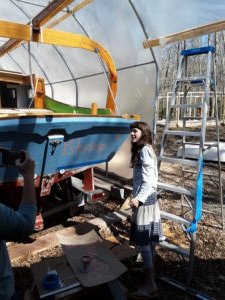
It happens, from time to time, that an alert reader or acquaintance will express wonder at the variety and amount of catchy phrases and witty material that emerge in my speech and writing. It’s tempting to nod sagely and let them think it all comes to me while meditating crosslegged on the head of a pin. The truth is, though, none of the material is original. My mind, which cannot remember the children’s birthdays nor any anniversaries, latches on to random things I read, and fetches them out later at unexpected times. All the names of everything I’ve ever named have come from some past literature, and have really no meaning other than that they sound cool.

So likewise the name we finally settled on for the tiny schooner I’ve been blogging about. Reading to the children at bedtime, one of PG Wodehouse’s well-known books, “Leave it to Psmith,” entered the rotation. The entire story hinges on, and gets full mileage, out of the silent ‘P’ that Psmith has added to the name. We were rolling with laughter when arrested by the ‘pshrimp’ that Psmith use to illustrate the silence of the ‘P.’ “That’s it!” I yelled. “That’s our name!”
Nothing is easy, not even getting five people to agree all at once on one thing. But we finally settled on that, and Emily painted it on the transom with appropriate pink paint, thus locking it in forever. Even though Pshrimp wasn’t quite ready to launch just then, it felt like the final step.

I’ve spoken before about my penchant for re-using wood—not only is is usually free, it’s often quite beautiful. Now the schooner had come with an adorably cute little spoked wheel, connected by cables and pulleys to the rudder. It was a pretty complicated system, and involved a lot of slop in the steering that I wasn’t sure I could tune out. It also contained many steel parts that were just dying to rust into oblivion. With a twinge of regret, I removed it all and fashioned a tiller out of a piece of oak I’d found discarded among some pallets and other packing stuff. To mend the opening where the wheel mechanism had been I built a lid out of mahogany salvaged from a wrecked 1930’s kit sailboat from Sears. Dressed up with varnish and a steering compass, it looked pretty good, and opened up more room in the cockpit.
Those details done (the rudder finished only the night before launch), we borrowed a friend with a big enough truck to back 3600 pounds of boat and trailer down a launch ramp and headed off to the nearest water. Is there a more exciting moment than when a boat you’ve been working on splashes for the first time? If there is, I don’t want to know it. In she went, out went the trailer, and at last she was afloat again! Since there was a bit of a line for the ramp, we walked her around to the outside of the wharf to start setting up the mast and sorting out the engine.



I had changed, with much labor, the impeller; I had put new fuel and new batteries in; I had changed the ignition switch—but I hadn’t ever fired her up. It was gut-wrenching to hear the starter scream, to get a cough and a puff of smoke, and have it die after a lazy chug or two. It took several agonizing tries, but finally the engine caught, I bumped the RPM up to 1500, and she steadied into a comforting rhythm. Whew!

Leaving the motor to warm up and settle in, we began stepping the masts. Luckily, we hadn’t got too far with that when the engine sputtered and died. Opening the engine box lid (as if seeing the motor would help), I saw water swishing among the engine mounts. Pshrimp was trying to psink! I had prepared for this, and it only took a moment to activate the electric bilge pump. Between that and the Whale Titan manual bilge pump I’d installed as well, we soon got the water out, and kept an eye on the bilge while I fiddled with the fuel primer pump and fired the diesel back up again.

An exploratory mission under all the floorboards revealed the source of the water: it was trickling in from the bolts that attached the oak keel to the boat. Well, nothing unusual there: after years of sitting in dry storage, the timber needed some time to swell up and seal itself again. Every wooden boat needs some time to “take up.” The question was, did we have enough time to let her take up while we occasionally pumped, or would she still be leaking when we had to leave? It might take as much as three or four days, and we only had that evening and part of the next day.
Reluctantly, I called our ride, who was already halfway back home with the trailer, and we down-rigged while he returned. We’ll try again soon, but must make sure we have a couple of days to stay aboard and monitor the water ingress. Until then, Pshrimp is parked on our property, waiting eagerly, like all of us, to get into the water again.